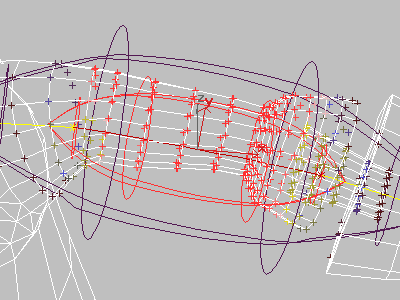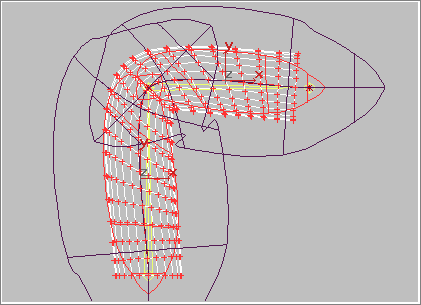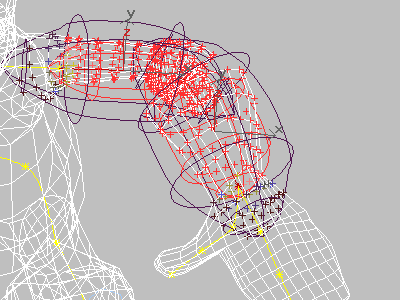The envelope is Physique's primary tool for controlling skin deformation. An envelope defines an area of influence about a single link in the hierarchy and can be set to overlap adjacent links. Vertices that fall in the overlap area of the envelopes are weighted to produce smooth blending at joint intersections. Each envelope comprises a pair of inner and outer bounds, each with four cross sections.

Envelopes
Deformable and Rigid Envelopes
There are two envelope types: deformable and rigid.


Deformable envelopes (above); Rigid envelopes (below)
Typically, you use deformable envelopes when you attach a mesh to the biped pelvis to produce a soft, flexible skin. Later you reassign certain links, such as the character's head, to the rigid envelope to minimize the deformation. For special cases, you can turn on both deformable and rigid envelopes for the same link. This advanced feature allows you to average the effect of the two types of skin deformation for additional firmness in the skin. The forearms and legs are sometimes good candidates for this.

Blending between envelopes controls deformation.
Blending controls specify the influence of overlapping envelopes on vertices contained within the overlap area. By the actual shape of adjacent envelopes, you can control the degree of influence each has on blending at the overlap area.
You can further control the number of envelopes that participate in the blending effect, or whether no blending takes place at all. Where you specify no blending, a vertex in an overlap area is influenced by a single link only.

Inner and outer bounds
Where a vertex falls within the inner and outer bounds determines the percent of influence of the attached link(s). Vertices that fall within the inner bound have a weight of 1. Vertices that fall between the inner and outer bound have a weighted value that falls off to 0 at the outer bound.
Vertices are color-coded in the viewports according to their weight; the color is based on parameters you specify in the Blending Envelope Display Options Dialog.
To address vertex-linking anomalies, the first step is to resize or reposition the envelope about the problem link. Most often, the problem is an envelope that is too small to surround, and thus influence, certain vertices.
Once you have adjusted inner and outer bounds of envelopes at the Envelope Sub-Object level, you may find you need still finer control: choose either the Cross Section or Control Point selection level in the Blending Envelopes rollout.
Use Vertex sub-object controls to customize vertex assignments.
This topic describes some options for controlling how envelopes display in the viewports.
Once you've got the deformable envelopes working the way you want to control overall skin deformation, you might want to adjust the finer aspects of skin control.
Vertices influenced by a rigid envelope follow the link itself rather than the deformation spline, as deformable vertices do. Low vertex-count models used for games are typically connected to the skeletons with rigid envelopes to simplify export to game engines. In such a case, each vertex can be simply described as assigned to a specific link. It can be located by giving a length along the link, a distance from the center of the link, and an angle around the link. As the link is transformed, all the vertices assigned to the vertex are uniformly transformed. This makes it simple for game engines to move the character's skin.
You can assign both Deformable and Rigid to a given link. For example, you might assign both to the shins, and size the envelopes differently to gain the benefits of both.
Physique creates a continuous spline through each of the joints in the hierarchy. The spline is represented by an orange line within the object. It maintains continuity through each joint: as a joint angle changes, the spline passing through the joint remains a smooth curve. Physique relies on the deformation spline to obtain smooth bends of the skin object. Physique offers bias and tension controls to adjust the shape of the deformation spline.
Most often, you use envelopes to correct the way skin behaves as the biped moves. However, you can override envelopes by assigning vertex properties manually.